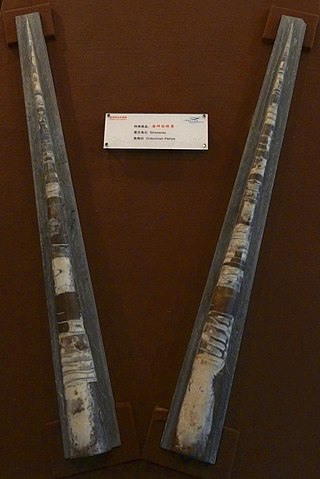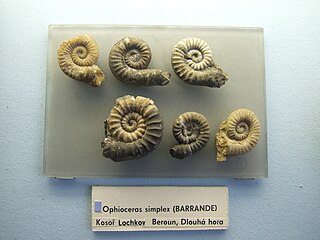Related Research Articles

Orthoceratidae is an extinct family of actively mobile carnivorous cephalopods, subclass Nautiloidea, that lived in what would be North America, Europe, Asia, Africa, and Australia from the Ordovician through Triassic from 490—203.7 mya, existing for approximately 286.4 million years.

Pseudorthocerida is an order of generally straight longiconic orthoceratoids with a subcentral to marginal cyrtochoanitic siphuncle composed of variably expanded segments which may contain internal deposits that may develop into a continuous parietal lining.. Cameral deposits are common and concentrated ventrally. Apices typically have a slight to moderate exogastric curvature
Paraloxoceras is a genus of straight shelled, orthoconic nautiloid cephalopods, now extinct, that lived during the Early Carboniferous. Fossils have been found in Europe and central Asia; the type, P. konincki, named by Flower, came from Belgium.
Pseudactinoceras is an extinct nautiloid cephalopod included in the order Pseudorthocerida and the namesake of the family Pseudactinoceratidae.
Jovellania is a genus of extinct prehistoric nautiloids from the order Oncocerida known from the Lower Devonian of Europe. Nautiloids form a broad group of shelled cephalopods that were once diverse and numerous but are now represented by only a handful of species in two genera.
Zittelloceras is an extinct genus of nautiloids from the order Oncocerida which are among a large group of once diverse and numerous shelled cephalopods, now represented by only a handful of species.

Sinoceras is an extinct genus of nautiloids from China included in the family Orthoceratidae that lived from the middle Ordovician until the Devonian. The type species, S. chinense, was originally described as "Orthoceras chinense," but then was promoted by Shimizu and Obata to its own genus, Sinoceras, in 1935.
Trigonoceras is an extinct genus of prehistoric nautiloids from the nautilid family Trigonoceratidae that lived during the Early Carboniferous in what is now western Europe.

Geisonoceratidae is an extinct family of orthoceroid cephalopods endemic to what would be Asia, Europe, and North America from the Middle Ordovician to the Middle Devonian living from about 470—380 mya, existing for approximately 90 million years. With the possible addition of an Early Cretaceous orthocerid from the western Caucasus the range of this group increases dramatically to some 350 million years, thus making it one of the longest lived families of the Nautiloidea.
Acleistoceras is a genus of the oncocerid, nautiloid family Acleistoceratidae that lived in the shallow seas that covered much of North America during the Devonian; living from 409—383.7 mya, existing for approximately 25.3 million years.

Dawsonoceratidae is an extinct family of orthoconic nautiloid cephalopods that lived in what would be North America and Europe from the Late Ordovician through the Middle Devonian from about 480–390 mya, existing for approximately 90 million years.
Arionoceras is an extinct orthocerid genus from the Middle and Upper Silurian, of Europe that is estimated to have lived from 422.9 to 418.1 mya, existing for approximately 4.8 million years.
Protobactrites is an extinct nautiloid cephalopod belonging to the Orthoceratoidea that lived in what would be Europe and Asia during the Ordovician and Silurian from 466–421.3 mya, existing for approximately 44.7 million years.
The Graciloceratidae is a family of nautiloid cephalopods from the Middle and Upper Ordovician belonging to the Oncocerida, characterized by exogastric cyrtocones that expand slightly or moderately and have thin walled, orthochoanitic marginal or subventral, tubular siphuncles.
Parakionoceras is an extinct nautiloid that lived during the Silurian and Devonian in what is now Europe; included in the orthoceratoid family Kionoceratidae in the Treatise part K, 1964 but removed to the Arionoceratidae in Kröger 2008.
Sceptrites is an orthoceratoid genus contained within the pseudorthocerid family Spyroceratidae known by its slightly compressed, possibly endogastrically curved, cyrtoconic shell. Sceptrites has been found in Devonian sediments in Ohio and N.Y. in the United States and in Victoria, Australia.
Tripteroceroides is a pseudorthocerid from the Lower Carboniferous (Mississippian) belonging to the family Spyroceratidae. Pseudorthocerids are nautiloid cephalopods with expanded siphuncle segments included in the superorder Orthoceratoidea.

Ophioceras is a genus of closely coiled tarphycerid nautiloid cephalopods, the sole representatives of the family Ophidioceratidae, characterized by an evolute shell with narrow, subrounded, annulated whorls and a subcentral siphuncle composed of thin connecting rings that show no evidence of layering. The mature body chamber is strongly divergent and is the longest proportionally of any tarphycerid. The aperture has a deep hyponomic sinus and ocular sinuses, and so resembles some lituitids.

Geisonoceras is an extinct orthocerid genus named by Hyatt, 1884, and type for the Geisonoceratidae established by Zhuravleva in 1959.
Dolorthoceras is a nautiloid cephalopod from the upper Paleozoic found in Lower Devonian to Lower Permian strata in North America, Europe, Asia, and Australia.
References
- Sweet, W.C. 1964. Nautiloidea -Orthocerida. Treatise on Invertebrate Paleontology, Part K. Geological Soc. of America and Univ of Kansas press.
- Spyroceras Paleobio db
- Sepkoski List - Cephalopoda